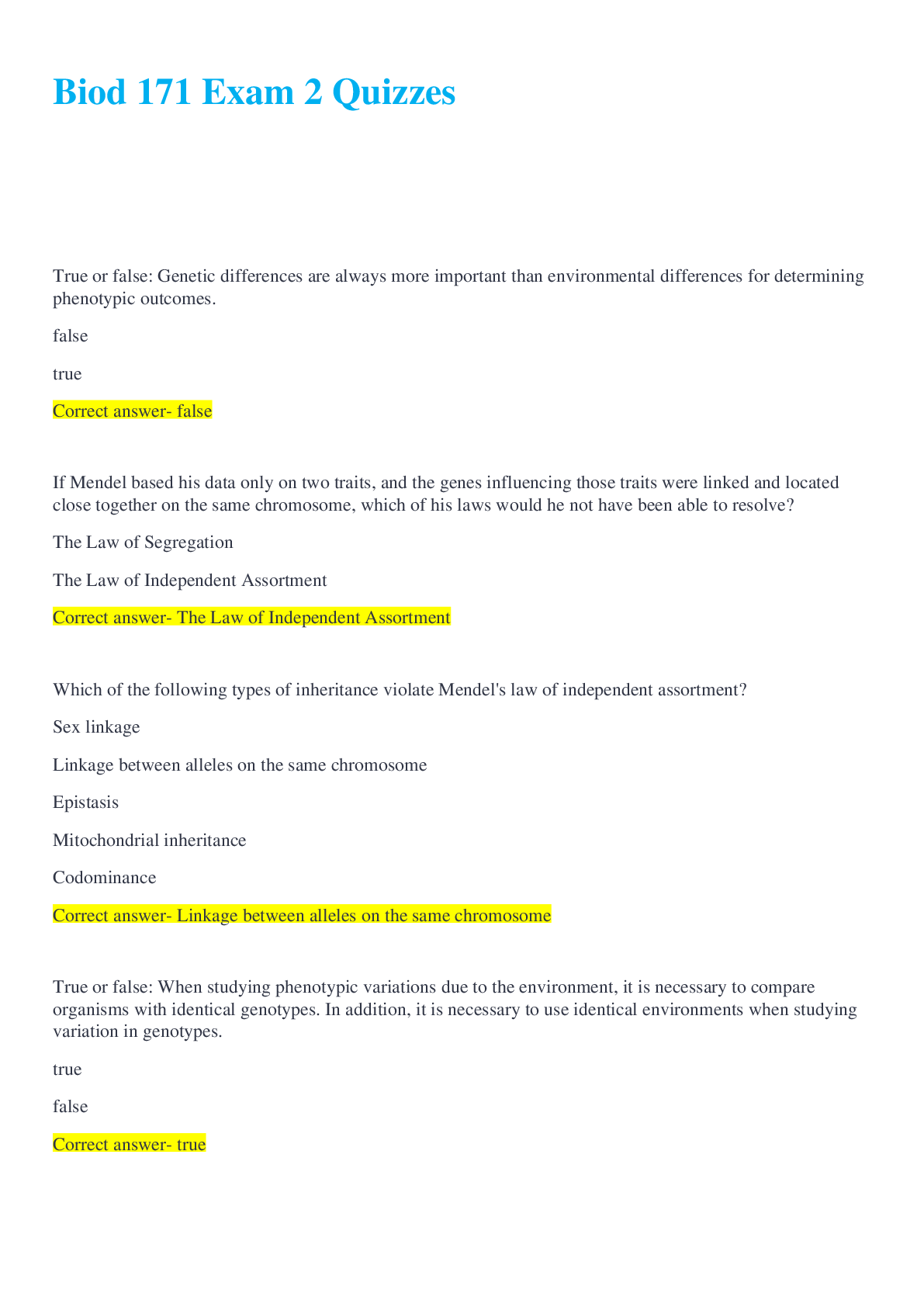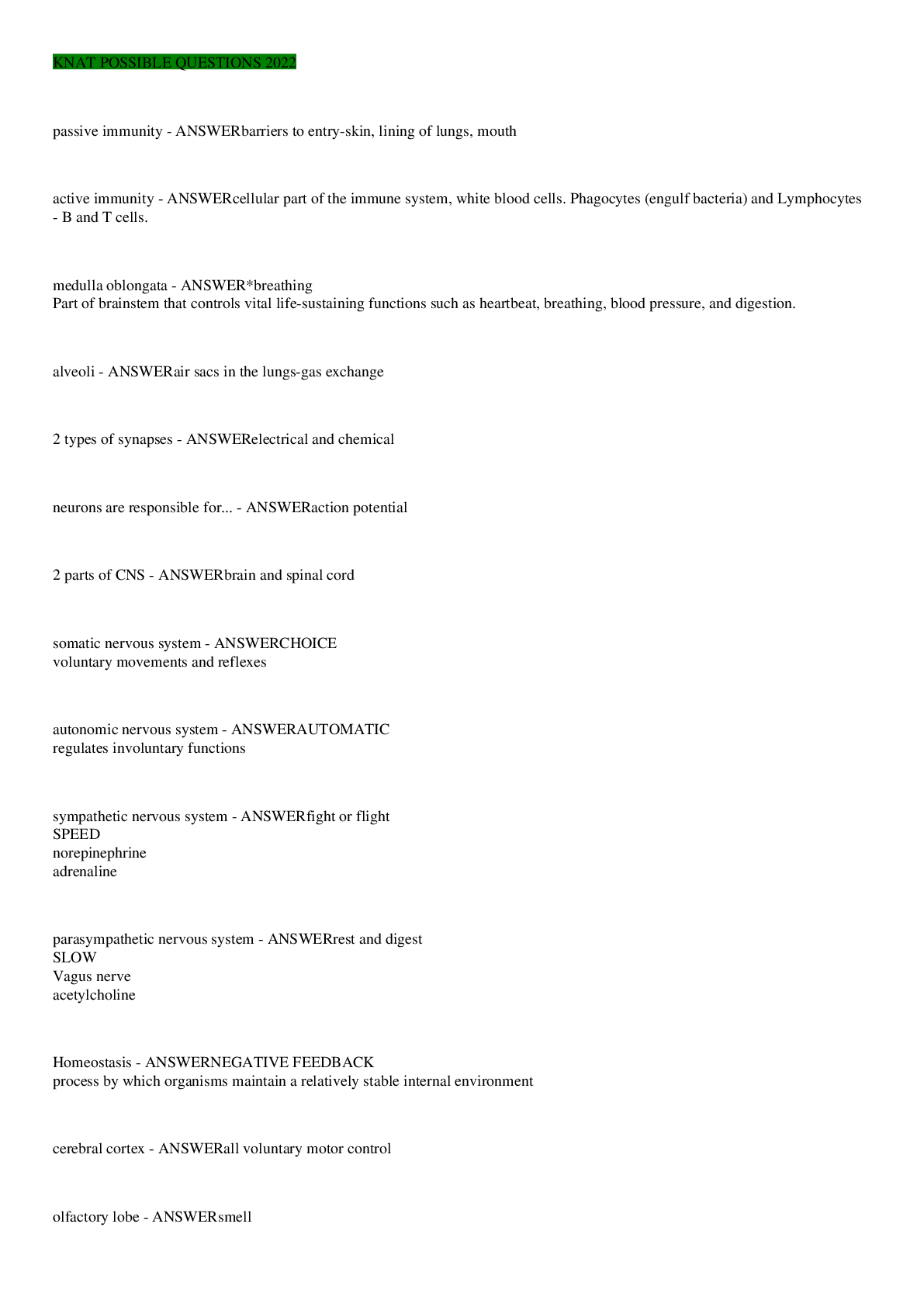Health Care > QUESTIONS & ANSWERS > ATI TEAS POSSIBLE QUESTIONS 2022 (Graded A) (All)
ATI TEAS POSSIBLE QUESTIONS 2022 (Graded A)
Document Content and Description Below
Respiratory System - ANSWEROxygen/carbon dioxide exchange (Lungs, trachea, larynx, nasal cavities, and pharynx) Breakdown of which of the following begins in the small intestine? A. Fats B. Fibe... r C. Proteins D. Carbohydrates - ANSWERA. Fats Which of the following is the tube that carries both sperm and urine for release outside the body? A. Ureter B. Urethra C. Vans deferens D. Epididymis - ANSWERB. Urethra Which of the following is the region of the kidney that contains the glomerulus of the nephron? A. Medulla B. Pelvis C. Cortex D. Adrenal - ANSWERC. Cortex Which of the following anti-body-secreting cells is triggered to proliferate upon vaccination? A. Erythrocytes B. B-lymphocytes C. Leukocytes D. T-lymphocytes - ANSWERB. B-lymphocytes Which of the following produces ammonia by deamination in the liver? A. Proteins B. Carbohydrates C. Nucleic acids D. Lipids - ANSWERA. Proteins A cross between two heterozygous F1 plants produces a ratio of 15:1 in the F2 offspring. Which of the following best describes the ratio? A. Modified monohybrid ratio B. Modified dihybrid ratio C. Normal monohybrid ratio D. Normal dihybrid ratio - ANSWERB. Modified dihybrid ratio The normal dihybrid ratio is 9:3:3:1, so this isi a modified dihybrid ratio. The monohybrid ratio is 3:1. Which of the following best describes matter in which the components cannot be broken down into simpler substances? A. Molecule B. Element C. Mixture D. Compound - ANSWERB. Element An element is a substance made of a single type of atoms that are generally held together by physical forces. Which of the following formulas best summarizes a simple replacement reaction? A. A+B= AB B. AB+C= AC+B C. AB+CD= AD+BC D. AB= A+B - ANSWERB. AB+C= AC+B This is a single replacement reaction because element B is replaced by element C. Which of the following structures stores urine before excretion? A. Kidneys B. Ureters C. Bladder D. Urethra - ANSWERC. Bladder Which of the following structures is an irregularly shaped bone? A. Femur B. Metacarpal C. Rib D. Vertebra - ANSWERD. Vertebra Vertebrae are irregular bones. The femur is a long bone. Metacarpals are short bones. Ribs are flat bones. In which of the following stages of embroylogical development are the main germ layers (ectoderm, endoderm, and mesoderm) formed? A. Blastula B. Morula C. Gastrula D. Fetus - ANSWERC. Gastrula During the gastrula stage, the germ layers are formed. During the blastula stage, the inner cell pmass and blastopore are formed. Embryogenesis is completed by the fetus stage. Which of the following nervous system directs the skeletal muscles to respond in the body's fight-or-flight response? A. Enteric B. Central C. Parasympathetic D. Sympathetic - ANSWERD. Sympathetic The Sympathetic Nervous System activates the body;s fight-or-flight response. In the presence of stress, the heart beats faster and stronger, more blood is carried to the vital organs, and the pupils dilate to prepare the body to defend itself. The Enteric peripheral nervous system controls the digestive glands. The central nervous system typically produces reflex arcs and processes external stimuli. The parasympathetic nervous system promotes responses that are the opposite of the sympathetic nervous system, such as digestion and maintenance. Exchange of gases occurs in which of the following structures of the respiratory system? A. Alveoli B. Bronchioles C. Trachea D. Pleura - ANSWERA. Alveoli The alveoli are the structures in the respiratory system in which the exchange of gases occurs. Although the bronchioles, trachea, and pleura are components of the respiratory system, they are not directly responsible for gas exchange. Integumentary System - ANSWERBarrier to invading organisms and chemicals, temperature control (skin, hair, subcutaneous tissue) Skeletal System - ANSWERSupports and moves body, protects internal organs, mineral storage, blood formation (bones, cartilage, ligaments, bone marrow) Muscular System - ANSWERLocomotion and heat production (muscles and tendons) Nervous System - ANSWERCoordinates activities of other organ systems and responds to sensations (brain, spinal cord, eyes, nerves, ears) Endocrine System - ANSWERRegulates body functions by chemicals (hormones) --Pituitary gland, parathyroid gland, thyroid gland, adrenal gland, thymus, pancreas, gonads Cardiovascular System - ANSWERTransports oxygen and nutrients to tissues and removes waste products (heart, blood, blood vessels) Lymphatic System - ANSWERReturns tissue fluid to blood, defends against foreign organisms (Spleen, lymph nodes, thymus, lymphatic vessels) Digestive System - ANSWERProcesses foods and absorption of nutrients into body (Stomach, intestinal tract, liver, pancreas, esophagus, and salivary glands) Urinary System - ANSWERElimination of wastes, regulates pH volume of blood (kidneys, urinary bladder, urethra) Reproductive System - ANSWERProduces germ cells (eggs and sperm) and environment for growth of fetus (female) -- Ovaries, uterus, mammary glands, testes, prostate glands, and external genitalia Process of Fermentation It is an example of an ___ process where ___ acts on a sugar solution to produce carbon dioxide and ___. - ANSWERanaerobic, sugar, alcohol Facilitated Diffusion - ANSWERThe movement of substances across a biological membrane using transmembrane integral proteins. Substances move down the concentrated gradient without the use of ATP hydrolysis as a form of energy. Ball and socket joints are ___-axial joints, which are highly mobile, allowing movement in ___ axes and planes. - ANSWERmulti, multiple Synovial Joints - ANSWERFreely moveable joints of locomotion Which of the following is not a lymphoid organ? A. Thymus B. Tonsils C. Spleen D. Liver - ANSWERD. Liver Lymphoid organs are parts of body that produce lymphocytes such as the thymus, spleen, and tonsils. The liver does not produce lymphocytes and is not a lymphoid organ. Which structure is not considered a part of the rib cage? A. Sternum B. Costal Cartilage C. The Thoracic Vertebrae D. The Lumbar Vertebrae - ANSWERD. The Lumbar Vertebrae They are found in the lower back and not considered part of the rib cage. Where are T Cells produced and matured? - ANSWERThey are produced in the bone marrow from progenitors, but they mature and develop in the thymus gland Deductive Rea [Show More]
Last updated: 1 year ago
Preview 1 out of 36 pages
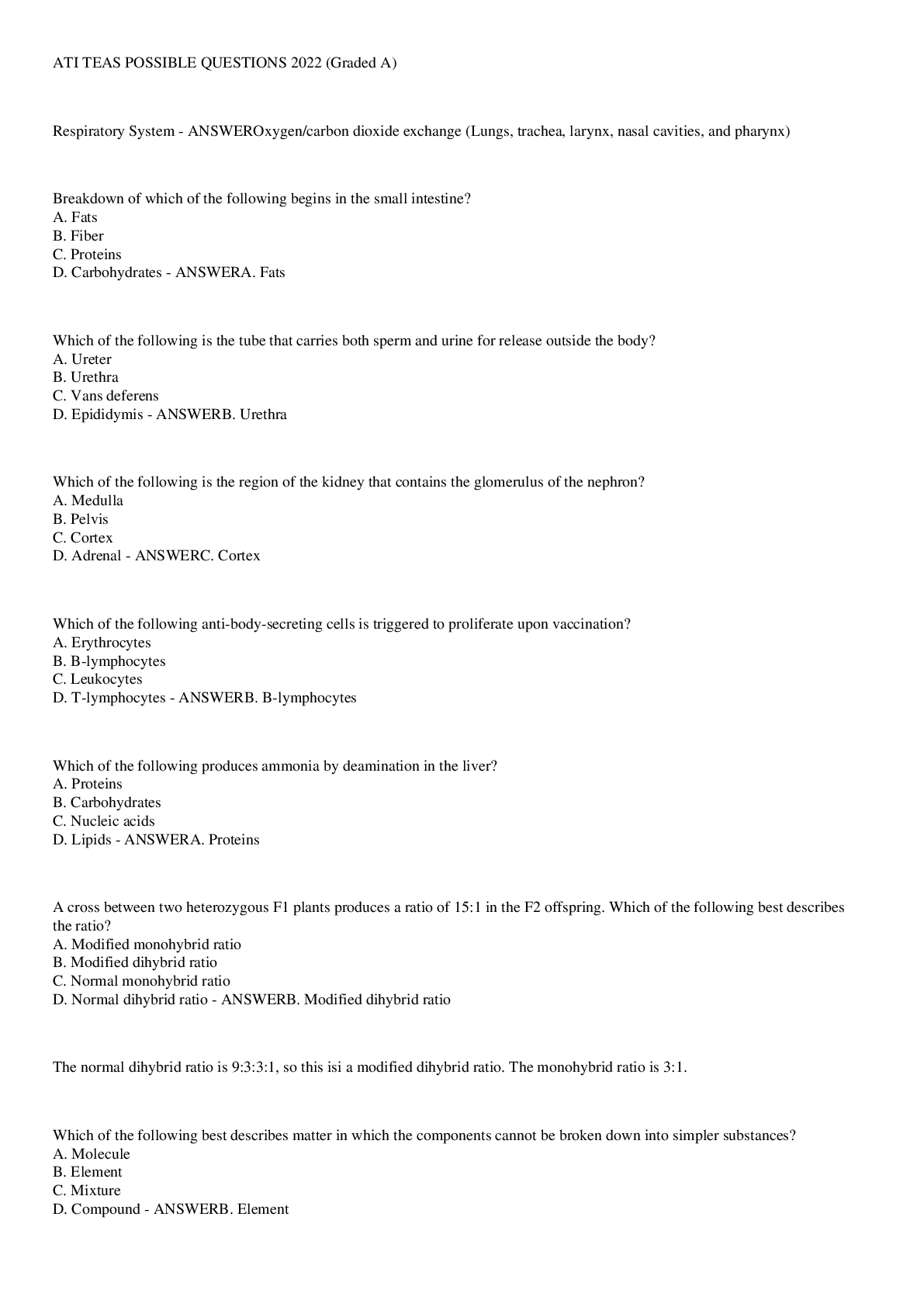
Buy this document to get the full access instantly
Instant Download Access after purchase
Add to cartInstant download
We Accept:

Reviews( 0 )
$12.00
Document information
Connected school, study & course
About the document
Uploaded On
Oct 05, 2022
Number of pages
36
Written in
Additional information
This document has been written for:
Uploaded
Oct 05, 2022
Downloads
0
Views
28

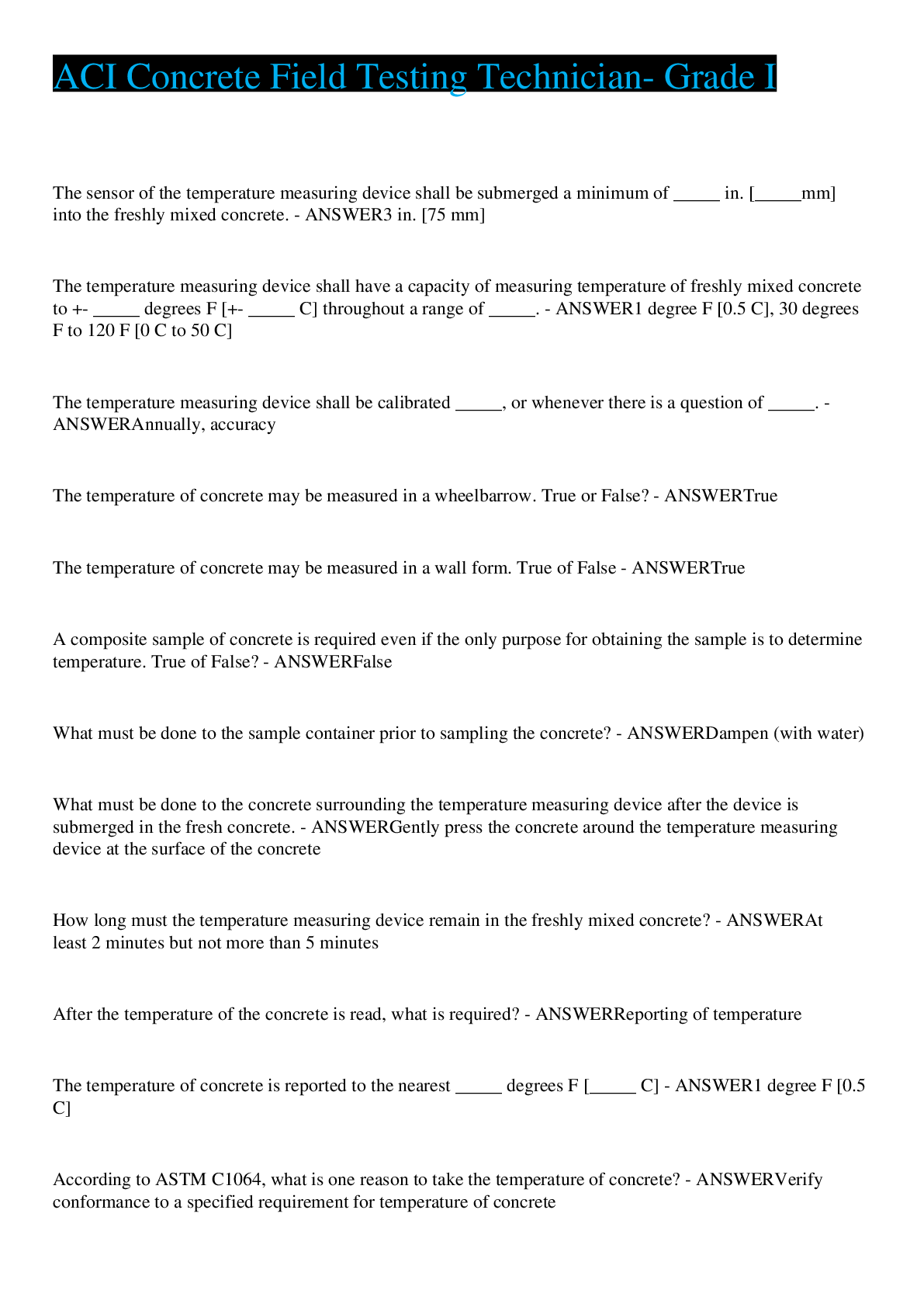


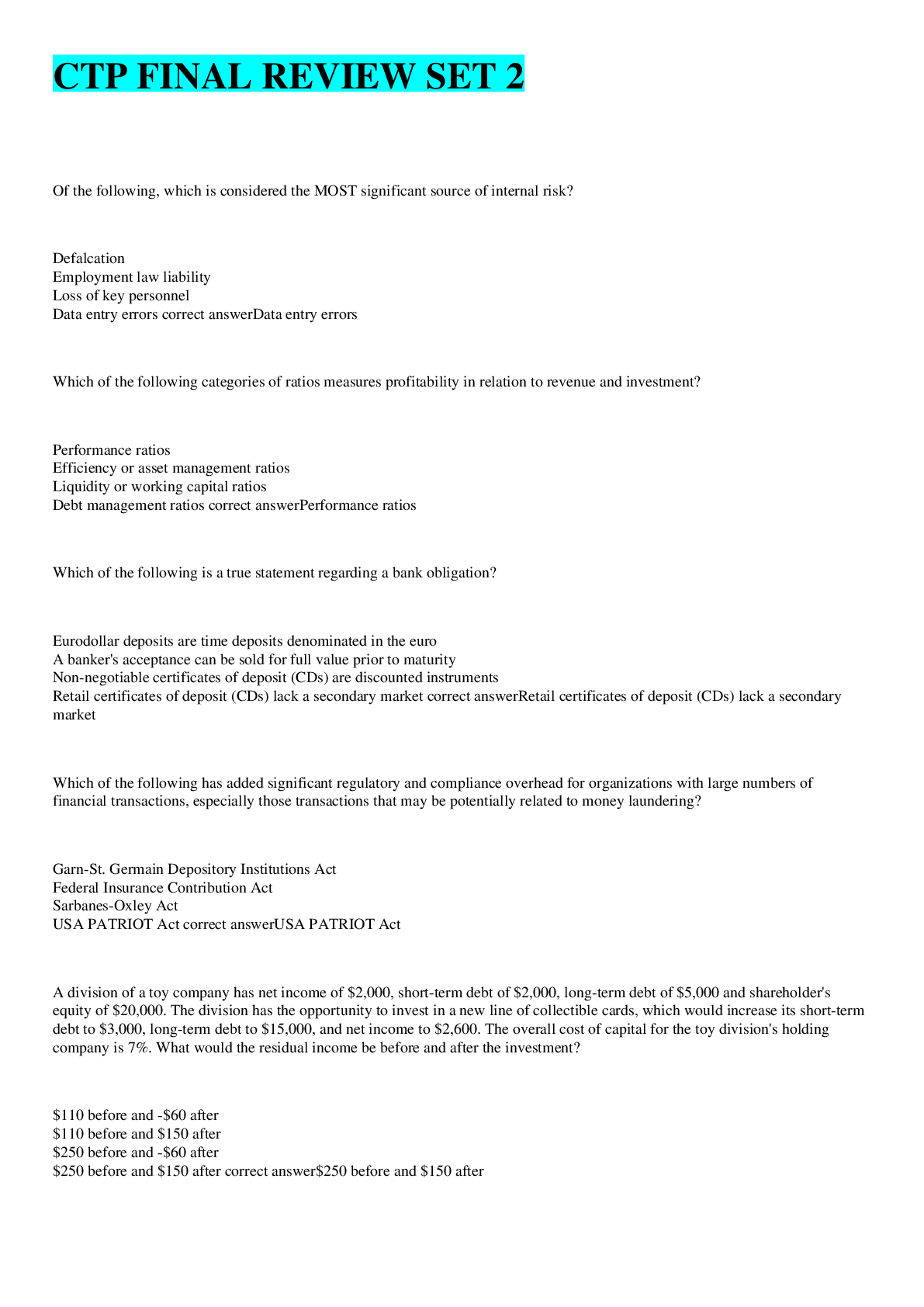
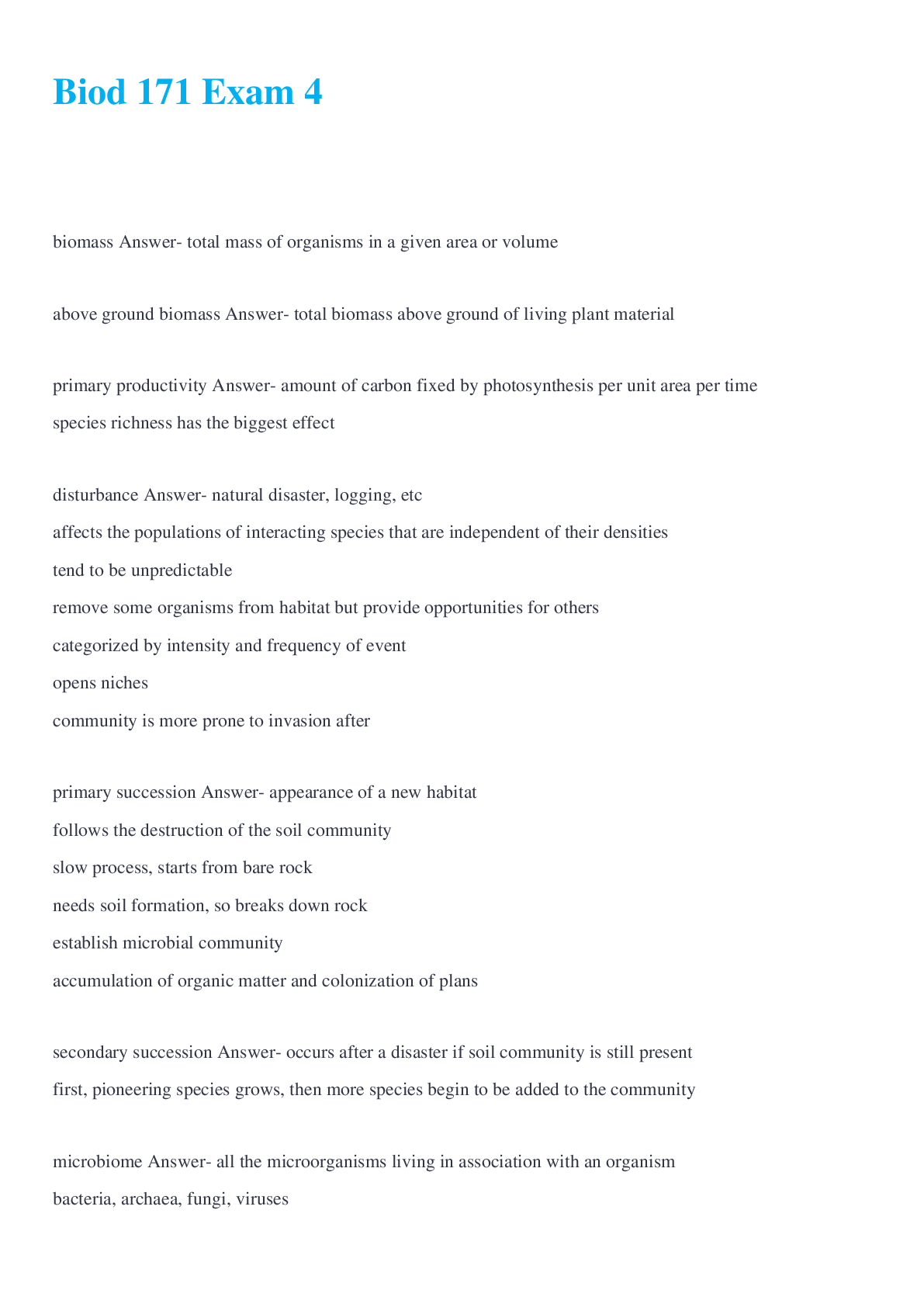
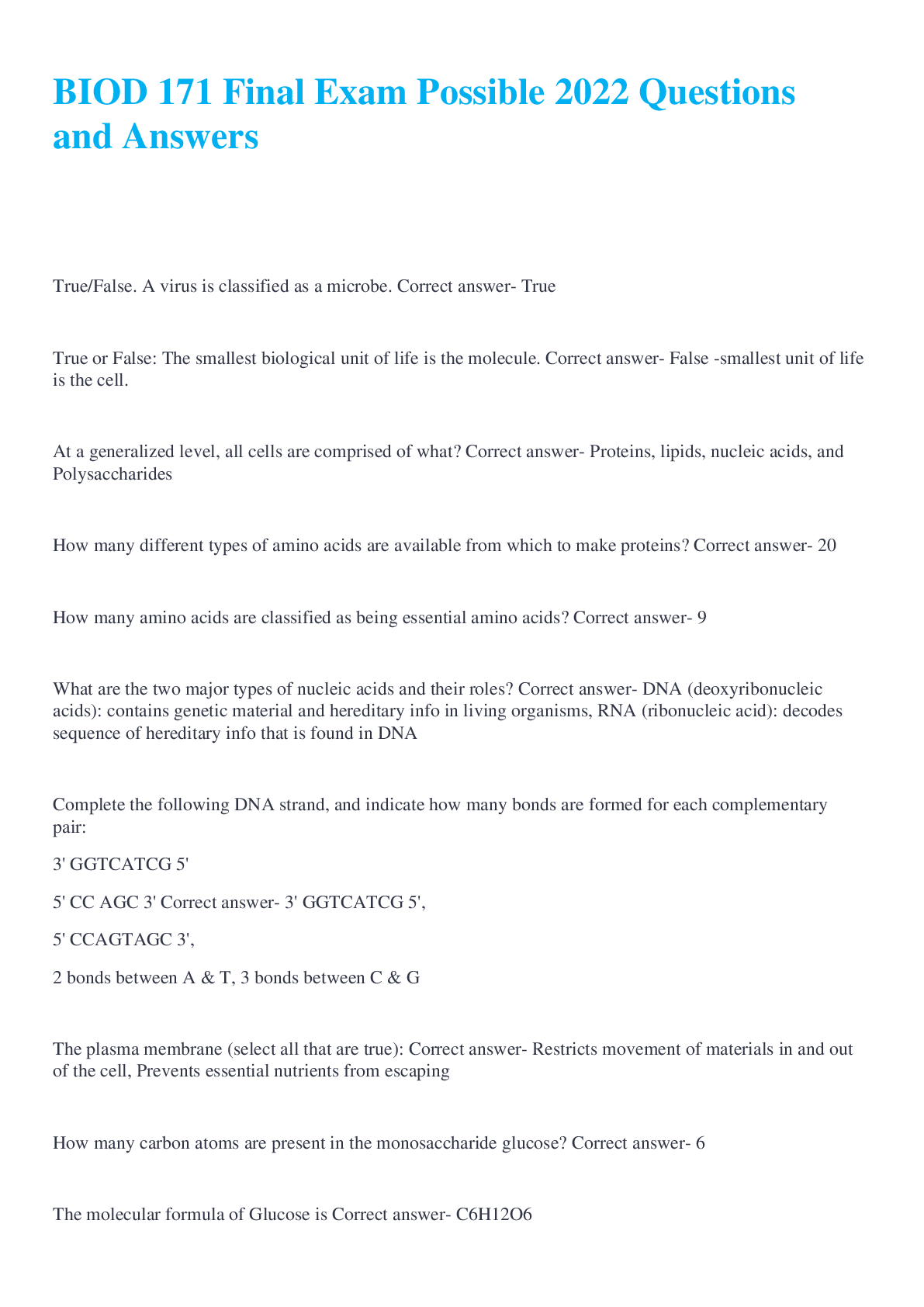
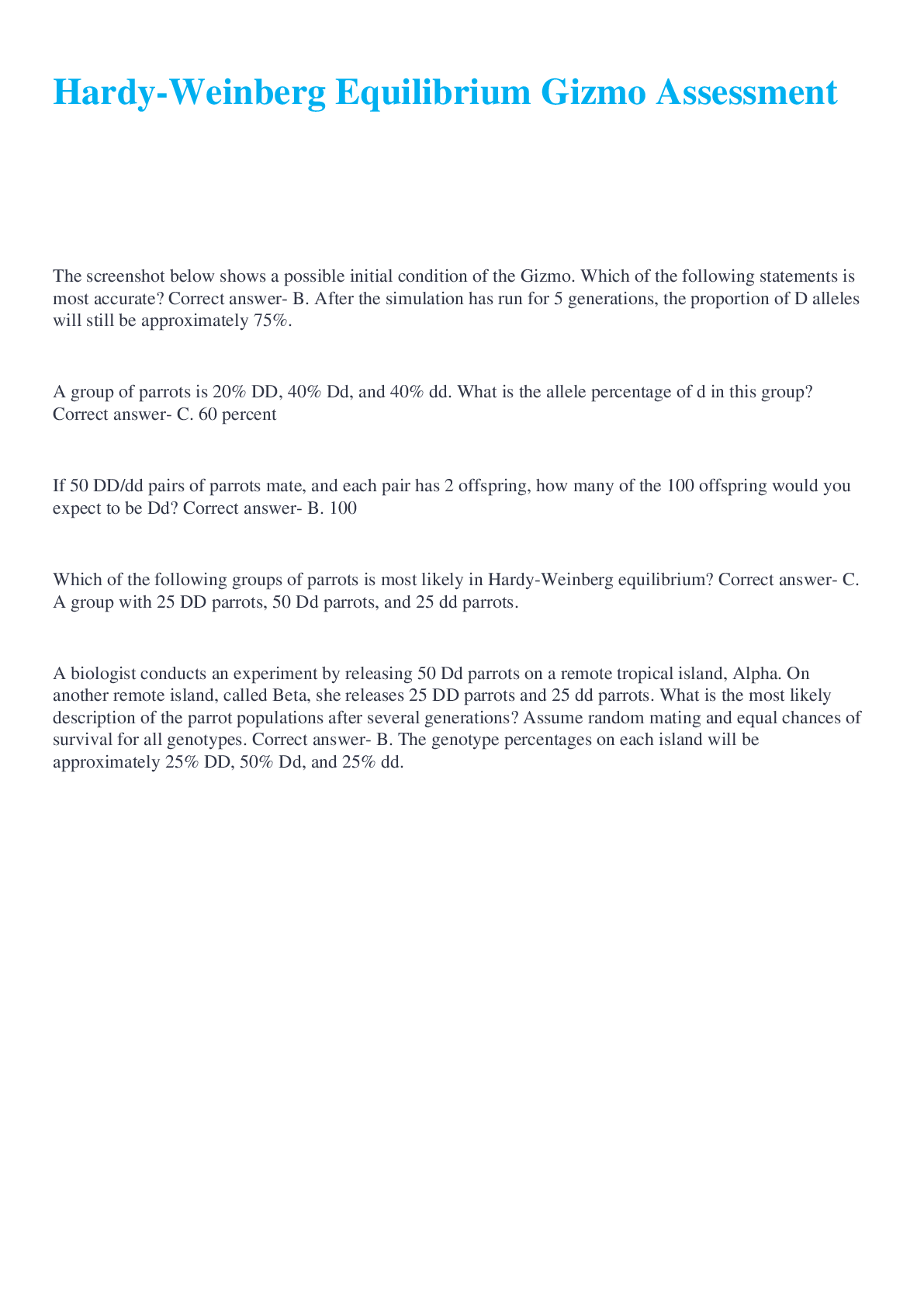
.png)
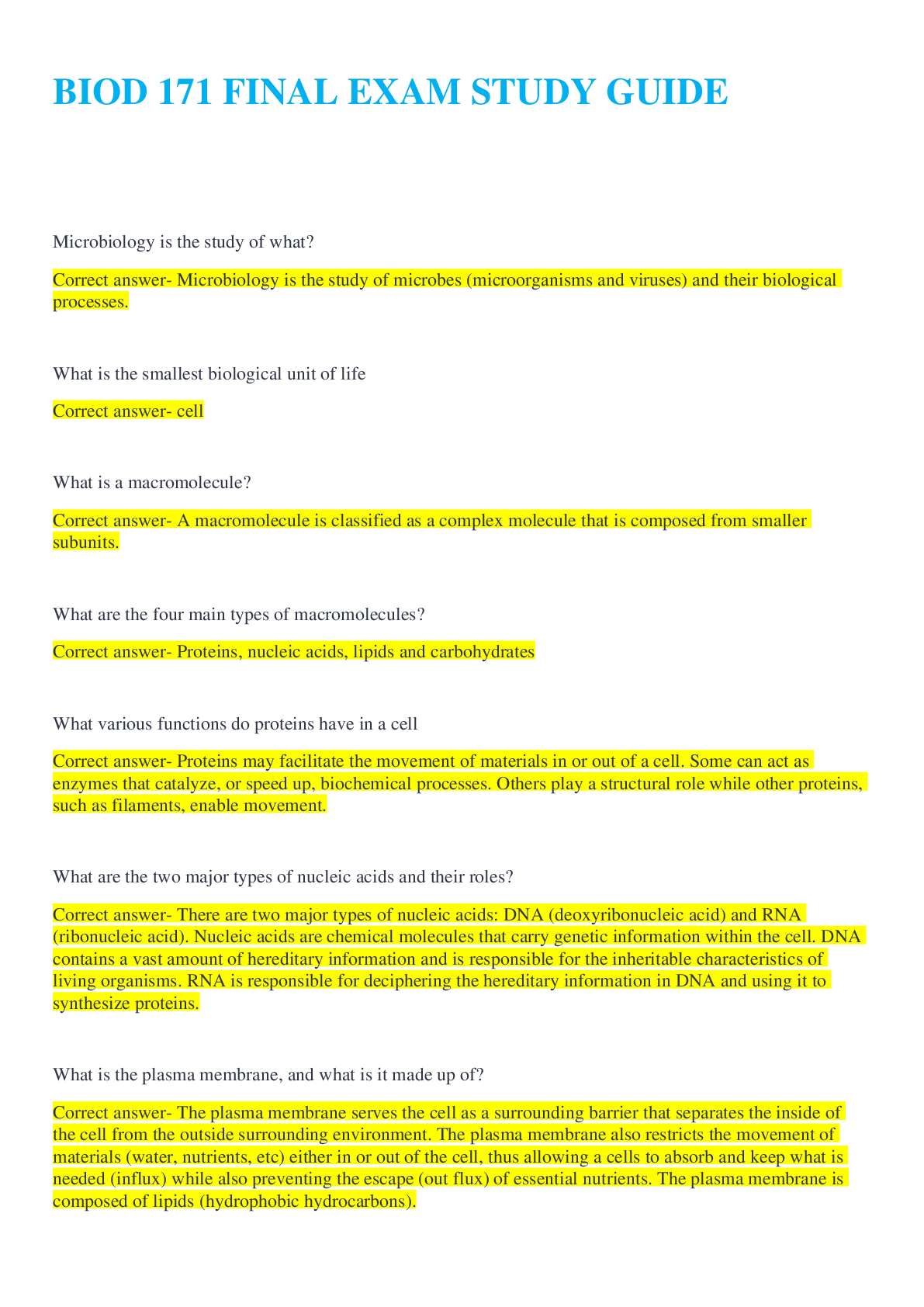
.png)

